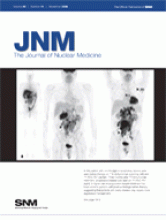Peptide-based imaging probes: Reubi and Maecke review the basic principles and application of somatostatin-derived, somatostatin-analog, and other emerging tracers for peptide receptors in a range of cancers.
Page 1735

To PIOPED or not to PIOPED: Reinartz provides a critical look at the relationship between the Prospective Investigation of Pulmonary Embolism Diagnosis studies (including data in an article in this issue of JNM) and the decline of ventilation–perfusion scintigraphy.
Page 1739
Perfusion scans and chest radiography: Sostman and colleagues access PIOPED II data and criteria to determine whether perfusion scintigraphy combined with chest radiography but without ventilation scans can offer clinically useful sensitivity and specificity in most patients.
Page 1741
Innovation in neuroimaging: Okumura and colleagues use 18F-fluoroethyl-SPA-RQ, a recently developed PET radioligand, to visualize and quantify the neurokinin 1 receptor in healthy humans and discuss implications for clinical research in psychiatric disorders.
Page 1749

Imaging leukemia with 18F-FLT: Buck and colleagues assess the suitability of this in vivo proliferation marker for visualizing extramedullary sites of acute myeloid leukemia and as a surrogate for disease activity.
Page 1756

H215O PET reproducibility in NSCLC: de Langen and colleagues document the reliability of serial monitoring of tumor perfusion using 15O-labeled water PET in patients with non–small cell lung cancer.
Page 1763

Sentinel node protocol in melanoma: Manca and colleagues detail an approach combining intraoperative node counting with staining, conventional histopathology, and molecular biology techniques for optimal detection of nodal metastases in patients with melanoma.
Page 1769

rhTSH and radiotoxicity: Rosário and colleagues compare recombinant human thyroid-stimulating hormone administration and levothyroxine withdrawal as pretreatments in reducing radiation damage in patients undergoing 131I thyroid remnant ablation.
Page 1776
PET in ENKTL: Suh and colleagues evaluate whether 18F-FDG uptake on pretreatment PET imaging is a predictor of treatment outcomes and survival in patients with extranodal natural killer/T-cell lymphoma of the head and neck.
Page 1783


Global and regional dyssynchrony and SPECT: Van Kriekinge and colleagues apply automatic phase analysis from gated myocardial perfusion SPECT to the characterization of ventricular contraction in patients with left bundle branch block.
Page 1790

Brain SPECT in fibromyalgia: Guedj and colleagues investigate and describe the specific clinical correlates of brain SPECT perfusion abnormalities in patients with fibromyalgia.
Page 1798

Uptake metric reproducibility: Nahmias and Wahl use standard 18F-FDG uptake values on serial PET/CT scans to estimate tumor metabolic activity in patients with various malignant diseases and to assess reproducibility for monitoring treatment efficacy.
Page 1804
90Y-ibritumomab in NHL: Iagaru and colleagues present observations from clinical experience with 90Y-ibritumomab in the radioimmunotherapeutic management of non-Hodgkin's lymphoma.
Page 1809
Surgery, imaging, and hyperparathyroidism: Judson and Shaha provide an educational overview of the role of nuclear medicine techniques in improving outcomes and advancing minimally invasive surgery in primary hyperparathyroidism.
Page 1813

Imaging SSTR2-positive tumors: Wadas and colleagues describe the synthesis, evaluation, and initial small-animal studies of a 64Cu-labeled somatostatin receptor subtype 2 (SSTR2)–selective antagonist with promise for imaging SSTR2-positive tumors.
Page 1819

Expression of an engineered antibody fragment: Wei and colleagues detail a new approach for reporter gene imaging based on cell surface expression of antibody fragments that can irreversibly bind to radiometal chelates.
Page 1828

Imaging reporter genes in MSCs: Roelants and colleagues explore the use of 18F-FHBG PET to image transduced mesenchymal cells infected with adenoviruses and retroviruses carrying the herpes simplex virus type 1 thymidine kinase gene.
Page 1836

Optical imaging of atherosclerotic plaques: Waldeck and colleagues describe in vitro studies using near-infrared fluorescence reflectance techniques to image macrophage-associated αvβ3 integrin expression.
Page 1845

Transmission scatter in PET: Vandervoort and Sossi investigate the effect of a previously validated method of scatter correction for singles-mode transmission data on quantitative accuracy in small-animal PET.
Page 1852
Hydrophilic 64Cu-ATSM derivative: Bayly and colleagues describe initial biologic experiences with a water-soluble glucose conjugate of the hypoxia tracer 64Cu-ATSM and compare the conjugate with 18F-FDG and 64Cu-ATSM in a rat model of sarcoma.
Page 1862
Adrenomedullin lung imaging: Harel and colleagues report on the development of human adrenomedullin derivatives radiolabeled with 99mTc and on the evaluation of their biodistribution, plasma kinetics, and utility as pulmonary vascular imaging agents.
Page 1869

MR-based PET attenuation correction: Hofmann and colleagues combine local pattern recognition and atlas registration to predict pseudo-CT images from a given MR image and then use the pseudo-CT images for PET attenuation correction.
Page 1875
MIRD Pamphlet No. 20: Wessels and colleagues present the latest in this widely respected dosimetry series, focusing here on strategies for predicting radiation toxicity to the kidneys.
Page 1884
ON THE COVER
In this patient with non-Hodgkin's lymphoma, lesions were seen before therapy on 111In-ibritumomab scanning (left) and 18F-FDG PET (center). Three months after 90Y-ibritumomab treatment, progressive disease was seen on 18F-FDG PET (right). A higher rate of progression despite treatment has been noted in patients with positive findings before therapy, suggesting that patients with bulky disease may require more aggressive management.

See page 1812.







